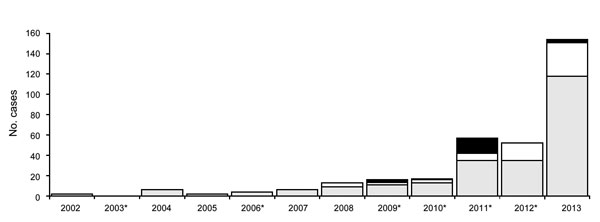Volume 21, Number 10—October 2015
Research
Epidemiology of Lyme Disease, Nova Scotia, Canada, 2002–2013
Figure 3

Figure 3. Number of reported Lyme disease (LD) cases, by case classification and year, Nova Scotia, Canada, 2008–2013. Black indicates probable cases—clinical illness and positive serology (2008–2013). White indicates probable cases—clinician-diagnosed erythema migrans and exposure to LD-endemic region (2008–2013). Gray indicates confirmed case—erythema migrans or other clinical illness and positive serology (2002–2007); previous definition plus exposure to LD-endemic region (2008–2013). Asterisk indicates years when LD-endemic regions were declared.
Page created: September 22, 2015
Page updated: September 22, 2015
Page reviewed: September 22, 2015
The conclusions, findings, and opinions expressed by authors contributing to this journal do not necessarily reflect the official position of the U.S. Department of Health and Human Services, the Public Health Service, the Centers for Disease Control and Prevention, or the authors' affiliated institutions. Use of trade names is for identification only and does not imply endorsement by any of the groups named above.